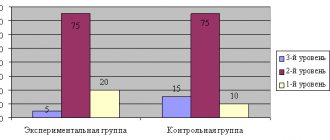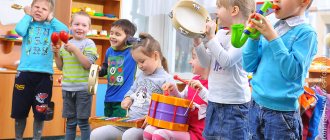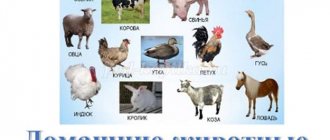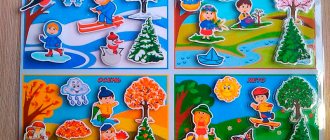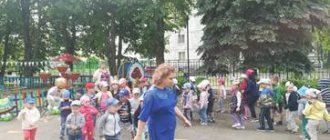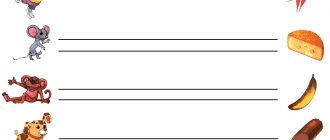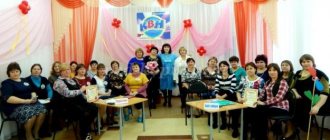MAGAZINE Preschooler.RF
Topic: “Modeling the world around us with little people”State budgetary preschool educational institution kindergarten No. 90 of the Kalininsky district of St. Petersburg
Directly - educational activities on cognitive-speech development and environmental education. preparatory group.
Program content:
- Develop complex forms of dialogic speech: detailed conclusions and judgments, inferences. Practice coherent speech and precise use of words.
- .Teach children the ability to listen to a friend, teacher, restrain themselves, and answer questions posed.
- Help the child develop a holistic understanding of the world around him, develop speech, logical, systematic thinking
To deepen children's understanding that everything around them consists of microscopic particles, which we will call “Little People”
,
(TRIZ elements*)
.
Reveal that ice is a solid substance, floats, and consists of water. Determine that ice melts from heat, that water freezes in the cold and takes the shape of the container in which it is located. Identify the properties of the stone (dry, hard, cannot be sculpted from it, cannot be divided into parts)
. Detect air in the surrounding space and determine its property - invisibility.
Use the object survey model*.
4. Teach children the ability to listen to a friend, teacher, restrain themselves, and answer questions posed.
Preliminary work:
- Observation of objects, what objects can be: (solid, liquid, gaseous ball, inflated with gel, hanging in the air without falling)
- Observation of the transformation of some solid objects into liquid, for example, ice cream, melting into liquid, and vice versa, liquid into solid (water in the cold)
.
Equipment and materials: various stones, boxes of sand, a model for examining objects, picture diagrams, a balloon, a bowl of water, an empty plastic bottle, sheets of paper, pieces of ice, ice molds. Models of people.
"Tough Men"
"liquid men"
"gaseous men"
A. Tukarov
Baby sing along with us.
If you jump from a tower in winter, you will, of course, get bumps. Know that the water was solid, You will answer without difficulty. Well, if you jump into the water in very warm weather, you will be wet to the skin: In summer, the ice can be liquid. Here's a leapfrog: Here there is ice, and here there is water. Think about it and answer: Is liquid a river or solid? Let's scoop up some water from the river and put it on the stove to heat. Steam will fill our entire house, but we won’t find water. Here's a leapfrog: There's steam here. And then water. Liquid - river or gas? You answer us right away. And water, and ice, and steam, Both young and old will tell you This is all water, You will remember forever!
V-l: Guys, Dunno brought us something in a box and asks us to tell him what it is. The children are looking. - What did Dunno bring us?
Children are stones.
V-l: - How are these stones similar?
Children act in accordance with the model: they press, knock.
All stones are hard.
Vs: - Pay attention to what kind of little people our stones are made of. I demonstrate a model of solids. Look how tightly our little people hold hands. All solid objects are made of such little men. What are the hardest objects you know?
The children answer.
V-l: If the solid men of stone separate their hands, what can happen.
Children: If you throw such a stone, it will break.
Vs: So, when the stone breaks, the solid men will come apart? How do the little people behave in the rubble?
Children: They are still hard. Holding each other's hands tightly
Game with pebbles “Post a picture”
—
Dunno hands out picture diagrams and offers to lay them out from pebbles. Children take trays of sand and lay out pictures according to the diagram.
Vs: - What do you think is the difference between liquid people and solid ones?
Children: - They don’t hold each other’s hands, but even if they do, it’s easy to tear them off. What kind of liquid people are there in the world?
Children: - Water, soup.
Vs: - No, there are hard people in the soup.
Children: - Cocktail, yolk, jellyfish, kefir, milk, sea, jam, slush, metal when it is melted, semolina, pancakes until they are fried.
V-l; I show a model of liquid substances. You see, the little men only hold each other with their elbows, so it’s easy to separate them.
I set out a bowl of water and throw ice in it. The children are looking.
How can you get multi-colored ice? Children: - Add paint to the water and put it in the cold.
Vs: - That's right. The liquid people will again hold each other with their elbows and our water will turn into ice. Let's do that. Place colored water in the cold.
V-l: I demonstrate a model of gaseous substances. – What do you think, what kind of man is this?
Children: Gas Man. Such little men run in different directions, and nothing can stop them.
Dunno asks a riddle about air.
It goes through the nose into the chest and goes back.
He's invisible and yet
We cannot live without him.
(Air)
Vs: What do we inhale through our noses? What is air? What is it for? Can we see it? Where is the air? How to find out if there is air around?
- Game exercise “Feel the air”
- children wave a sheet of paper near their face. How do we feel? We don't see air, but it surrounds us everywhere. - Do you think there is air in an empty bottle? How can this be checked? We lower the empty transparent bottle into a bowl of water until it begins to fill with water. What's happening? Why do bubbles come out of the neck? This water displaces the air from the bottle. Most objects that appear empty are actually filled with air.
- Name the objects that we fill with air. Children inflate balloons. What do we fill the balloons with?
Air fills every space, so nothing is empty.
V-l; Today we met with the various little people who make up everything around us. Do you remember what they are called? Children's answers. Well done, everyone was attentive, remembered everything and listened.
| Next > |

